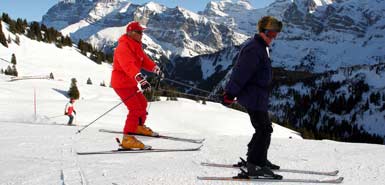Jon Swain - writer and foreign correspondent
Is 50 too late to ski?
Not a bit of it: our correspondent heads for the Alps to prove it’s never too late to find your ski legs
Jon Swain
The Sunday Times travel, 14 January 2008
The medical advice was clear. “Don’t do it,” my doctor told me when I announced, well into my fifties, that I was going to the Alps to learn to ski.
It’s what his father had warned him when he first began medical practice. “Much better if you stay home in Hampstead,” he’d said, “and make money treating all the patients who go on skiing holidays and come back to London with broken bones.”
Obviously, he thought I was going to be one of the fools coming back from the slopes in plaster.
But my younger associates were much more encouraging. “There’s nothing to it,” they said. “It’s never too late to learn.” Young people say things like that all the time, of course. But they also pointed out that over the past 10 years ski equipment has improved enormously, and it’s now much easier and safer to master the basics. This was good news – but, to be honest, I’d already made up my mind. Skiing has been on my To Do list since the 1970s, and I wasn’t going to let half a lifetime’s ambition fade away so easily. So I ignored medical opinion and headed out to the mountain resort of Courchevel, in France.
Once I’d met my instructor, I realised how petty my anxieties had been. His name is Roger Blanc, and he is the roi of instructors at the Ecole du Ski Français (ESF), the French ski school in Courchevel. He’s 60.
Blanc has been a ski instructor for some 30 years. But what’s really remarkable about his story is that 10 years ago, incapacitated after brain surgery, he was forced to relearn skiing completely from scratch. It took him an entire winter to master going down even a nursery slope, but he stuck at it and now he is a superb skier again. A bit of a legend in Courchevel, he has made teaching older skiers a speciality.
Blanc made it clear from day one that it is never too late to give skiing a go. He told me about one of his clients, a Frenchman, whom he taught to ski at the age of 62. Today, in his seventies, the man skis the most difficult pistes in Courchevel without difficulty or a frisson of concern. Blanc insisted I would be able to do the same and did not make any allowances for my age, as far as I can tell.
There is one small problem with the miracle Blanc method, however. He only speaks French. I had no problem with this because I speak French. But I wouldn’t advise it for anyone who doesn’t, because there’s nothing like the stress of falling over to dent your foreign-language skills. Besides, the ESF has many fluent English-speaking instructors among the 470 on its books, and there are several British ski schools now operating in the resort as well.
So much for the theory. The practice was, of course, rather less straightforward. On the resort’s nursery slopes, Blanc’s first lesson was basic enough. I learnt to glide in a straight line across a gentle incline and then push off from one ski to another in a skating motion to get extra momentum. The basic snowplough (the chasse-neige) wasn’t hard either, especially given the easy, unthreatening slope. Most English lawns have more pitch to them than this one did.
But mastering parallel turns was far trickier. For a start, we had to find a (slightly) steeper slope on which to try them. Most skiers wouldn’t even have noticed the difference, but, for me, the sudden increase in speed was alarming. Trying to remember which foot to unweight, and which edge of which ski to press into the snow – when every instinct in your body is screaming “STOP!” – is not an easy process. More often than not, I used my friend Catherine as a brake.
“Jon,” she said after yet another pile-up, “you may hang onto my rucksack and mistakenly cross your skis on the back of mine, but you may not do both things at the same time. I knew what she meant, but that didn’t stop me resorting to the manoeuvre whenever I felt myself losing control. Fortunately, none of our spills was at a high enough speed to cause serious damage.
After a week, I was still not able to ski with my head facing down the fall line, knees pulled tight towards the chest and arms forward, as Blanc did. Nor could I make split-second turns. But I got the hang of the rudimentary manoeuvres. And every day I grew a little more infatuated with the mountains. If you’ve never seen the Alps in winter, it’s hard to understand how inspiring they can be. But as Catherine and I sat on the lift each day, soaking up the sun-drenched scenery, we were both convinced that we’d take whatever punishment skiing could throw at us, so long as it meant we could enjoy places like Courchevel each winter.
In the end, I returned home with two exhausted legs and a sore knee and shoulder, but no serious injury. I also returned with a craving to get back on skis as soon as possible.
Maybe I’ll persuade the doctor to come on the next trip, too.

